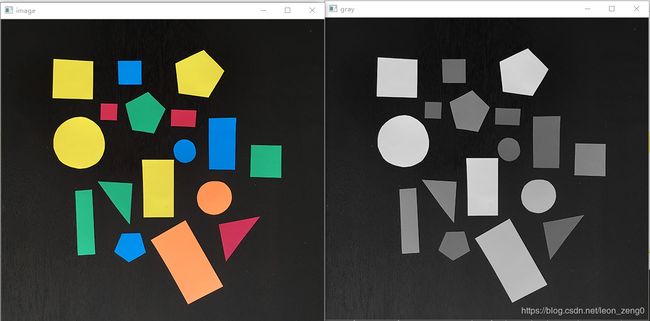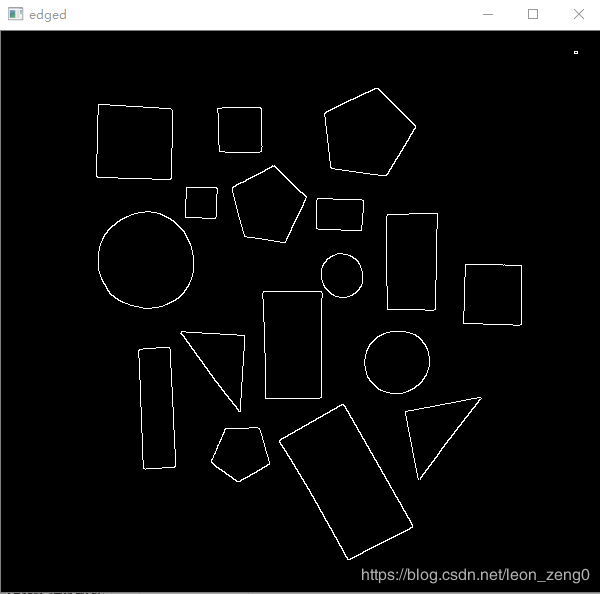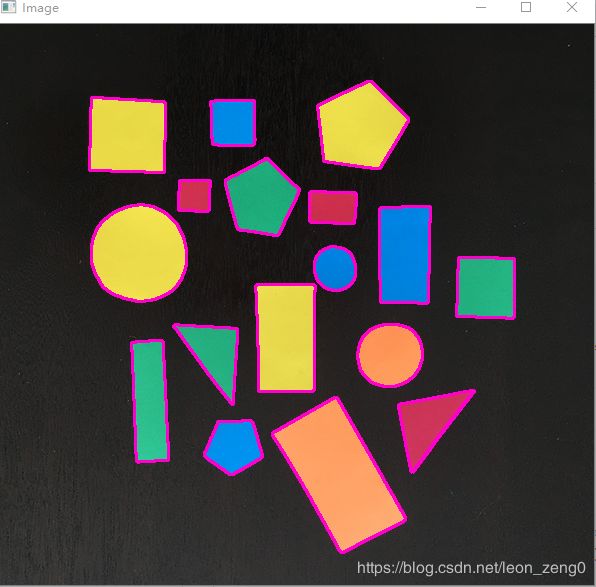Python 下opencv 应用: 物体数数
物体数数,物体个数计算,就是计算一个图形中有多少物体。
python 下用opencv 打开一个图形文件,图形处理,计算图中物体的个数。
除了opencv 要安装好外,还要装好‘imutils。imutils 的下载和安装在 Python 下应用opencv 的简单功能演示 一文中有介绍。
这个原始代码来自 https://www.pyimagesearch.com/2016/11/21/raspbian-opencv-pre-configured-and-pre-installed/ 的一个教学讲稿。
代码讲解
先看开始的代码,使用方法:python count_shapes.py --image images/shapes.png
后面images/shapes.png是需要处理的图形文件名字,可以在命令行改变,看不同的图。
输入必要的程序包,argparse,imutils, cv2
然后是命令输入行参数分析,得到需要处理图形文件名,缺省是images/shapes.png
# USAGE
# python count_shapes.py --image images/shapes.png
# import the necessary packages
import argparse
import imutils
import cv2
# construct the argument parser and parse the arguments
ap = argparse.ArgumentParser()
ap.add_argument("-i", "--image", default='images/shapes.png',
help="path to the input image")
args = vars(ap.parse_args())输入图形文件到image , 核查文件名 print args["image"],这是可以在命令行输入的文件名。
彩色图变灰色,显示原图和灰色图。
# load the input image and convert it to grayscale
print(args["image"])
image = cv2.imread(args["image"])
gray = cv2.cvtColor(image, cv2.COLOR_BGR2GRAY)
cv2.imshow('image',image)
cv2.imshow('gray',gray)高斯降噪,边缘检测,得到轮廓图,显示轮廓图。
# blur the image (to reduce false-positive detections) and then
# perform edge detection
blurred = cv2.GaussianBlur(gray, (3, 3), 0)
edged = cv2.Canny(blurred, 50, 130)
cv2.imshow("blur",blurred)
cv2.imshow('edged',edged)在轮廓图中,寻找轮廓列表,初始化计算为0
# find contours in the edge map and initialize the total number of
# shapes found
cnts = cv2.findContours(edged.copy(), cv2.RETR_EXTERNAL,
cv2.CHAIN_APPROX_SIMPLE)
print(cnts)
cnts = imutils.grab_contours(cnts)
total = 0循环每一个轮廓,计算轮廓包含的面积像素个数,太小(25),就认为是噪声,忽略掉。
正常的话,画图轮廓,计数+1。
# loop over the contours one by one
for c in cnts:
# if the contour area is small, then the area is likely noise, so
# we should ignore the contour
if cv2.contourArea(c) < 25:
continue
# otherwise, draw the contour on the image and increment the total
# number of shapes found
cv2.drawContours(image, [c], -1, (204, 0, 255), 2)
total += 1打印出总物体个数,并显示勾画轮廓的图形。
# show the output image and the final shape count
print("[INFO] found {} shapes".format(total))
cv2.imshow("Image", image)
cv2.waitKey(0)打印显示的结果是:
images/shapes.png
[INFO] found 17 shapes
有17个,数一数,对吗?
最后列出完整的代码
# USAGE
# python count_shapes.py --image images/shapes.png
# import the necessary packages
import argparse
import imutils
import cv2
# construct the argument parser and parse the arguments
ap = argparse.ArgumentParser()
ap.add_argument("-i", "--image", default='images/shapes.png',
help="path to the input image")
args = vars(ap.parse_args())
# load the input image and convert it to grayscale
print(args["image"])
image = cv2.imread(args["image"])
gray = cv2.cvtColor(image, cv2.COLOR_BGR2GRAY)
cv2.imshow('image',image)
cv2.imshow('gray',gray)
# blur the image (to reduce false-positive detections) and then
# perform edge detection
blurred = cv2.GaussianBlur(gray, (3, 3), 0)
edged = cv2.Canny(blurred, 50, 130)
#cv2.imshow("blur",blurred)
cv2.imshow('edged',edged)
# find contours in the edge map and initialize the total number of
# shapes found
cnts = cv2.findContours(edged.copy(), cv2.RETR_EXTERNAL,
cv2.CHAIN_APPROX_SIMPLE)
cnts = imutils.grab_contours(cnts)
total = 0
# loop over the contours one by one
for c in cnts:
# if the contour area is small, then the area is likely noise, so
# we should ignore the contour
if cv2.contourArea(c) < 25:
continue
# otherwise, draw the contour on the image and increment the total
# number of shapes found
cv2.drawContours(image, [c], -1, (204, 0, 255), 2)
total += 1
# show the output image and the final shape count
print("[INFO] found {} shapes".format(total))
cv2.imshow("Image", image)
cv2.waitKey(0)


